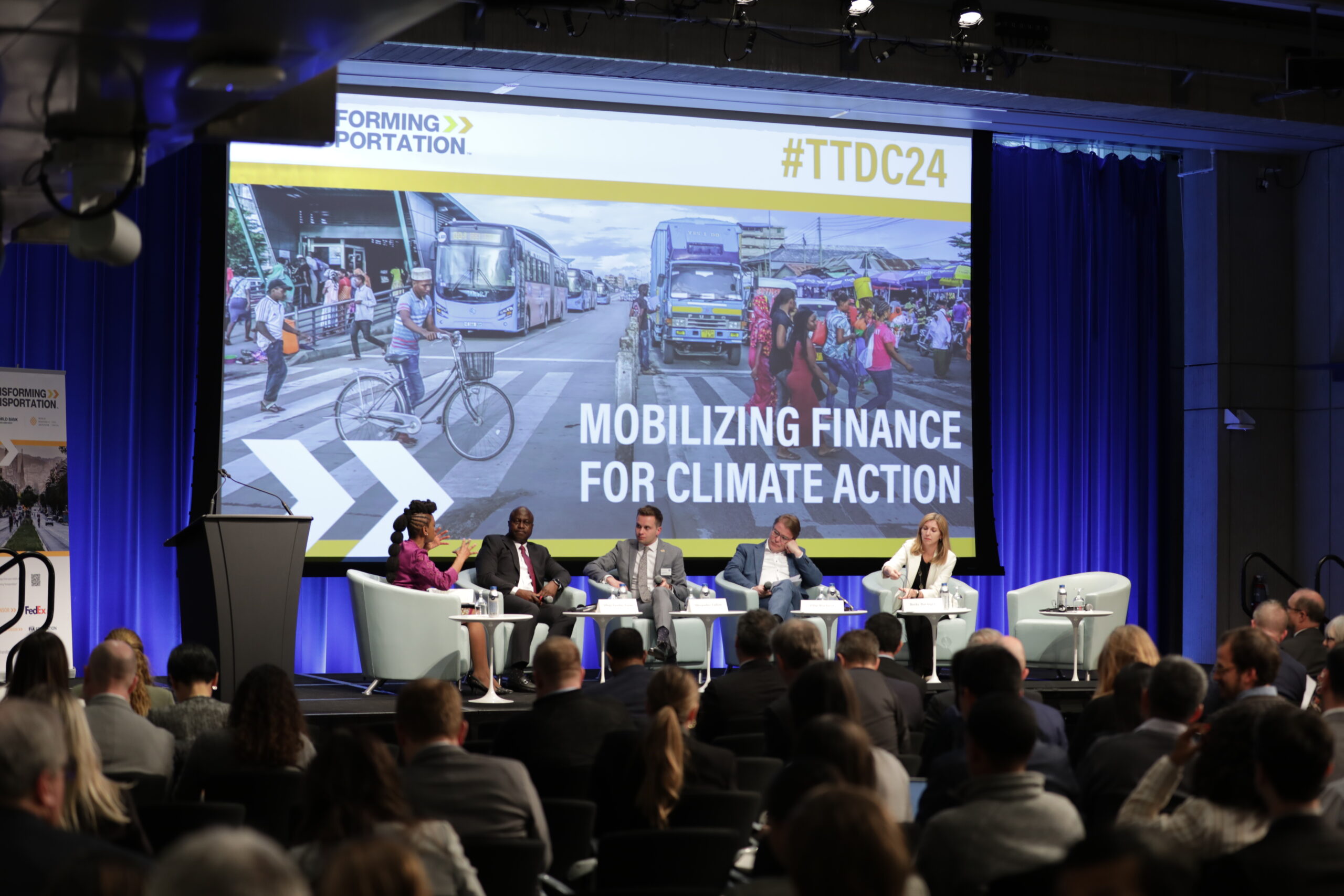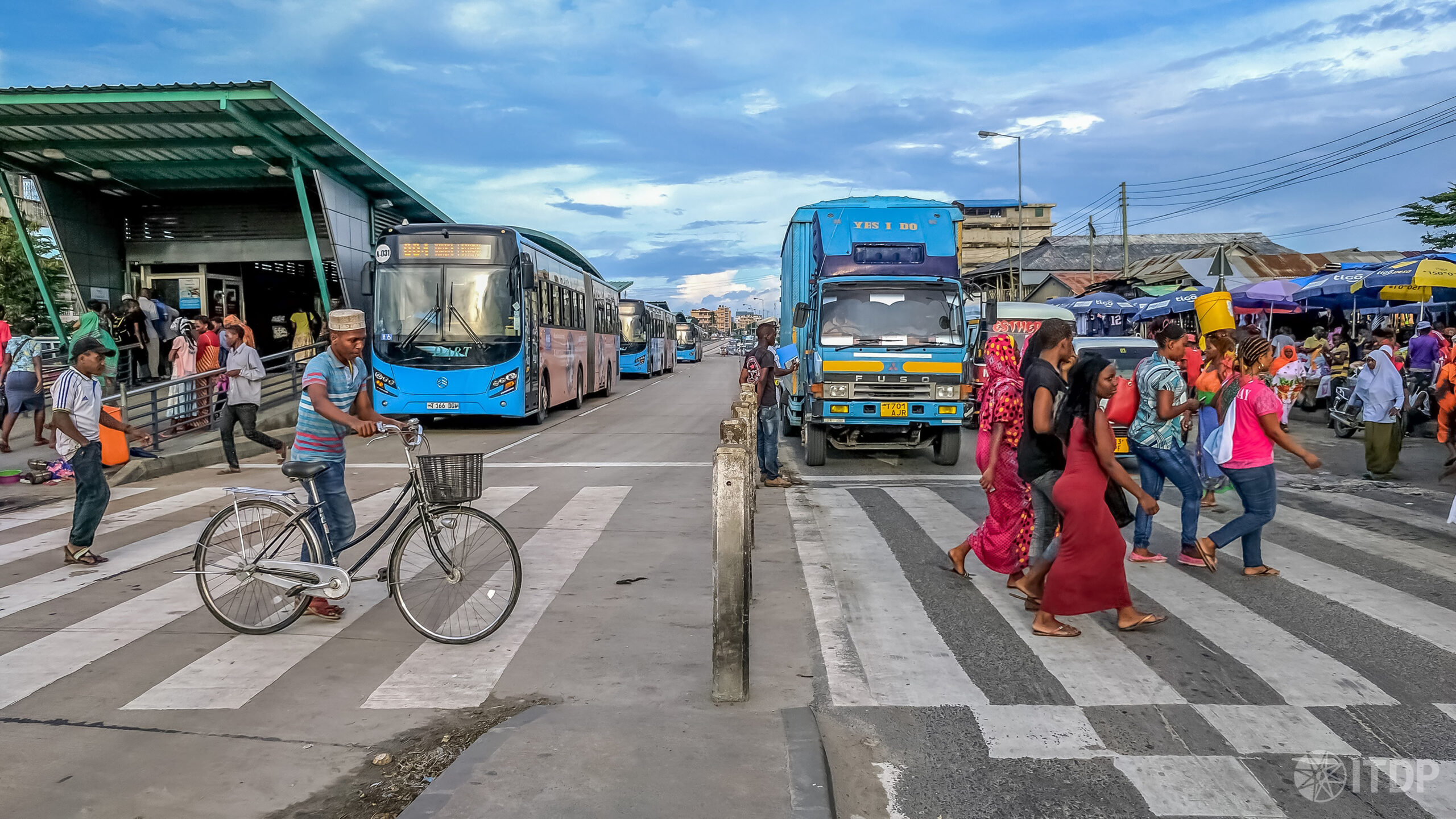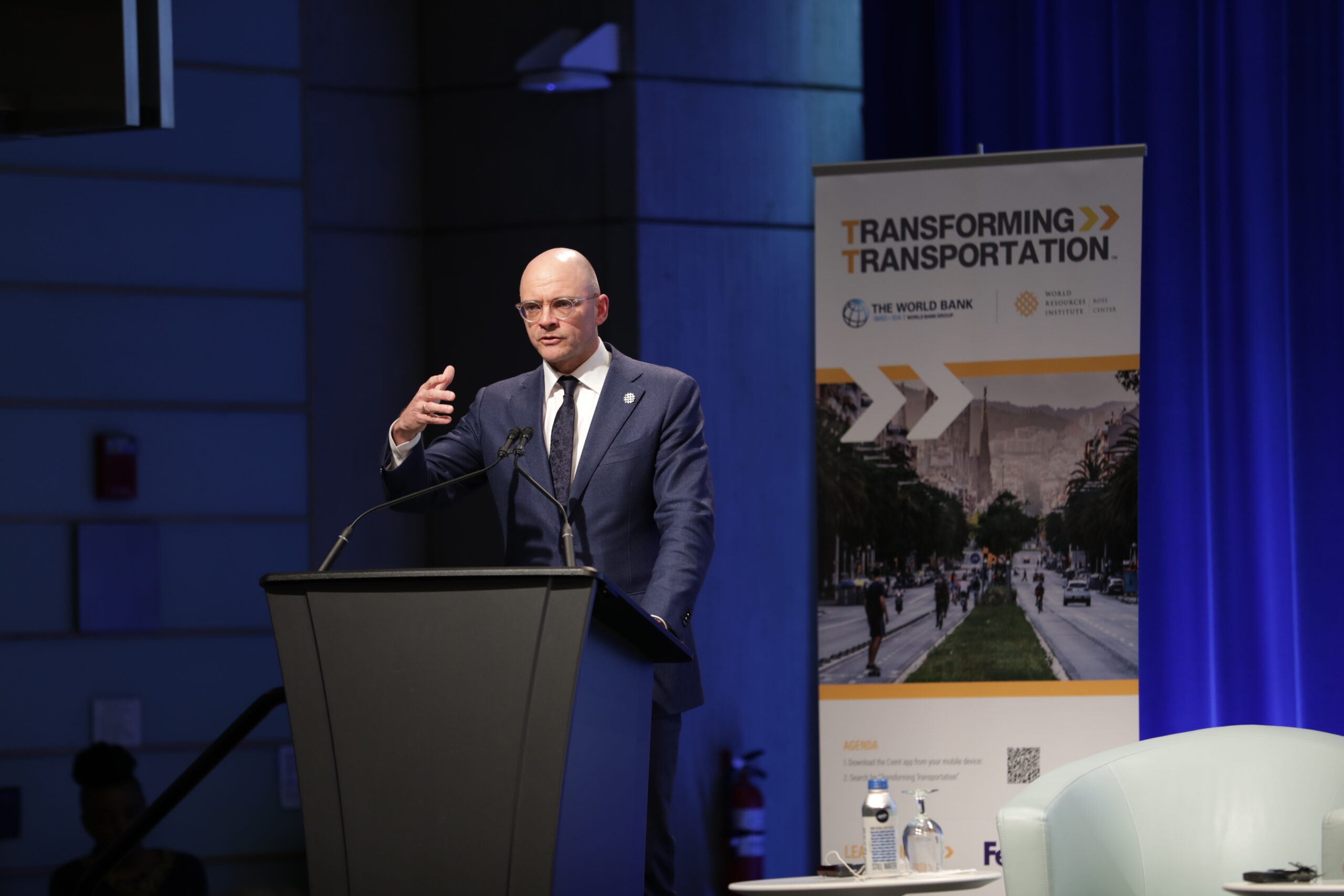
If a picture can tell a whole story, then the image below of an intersection in Dar es Salaam, Tanzania, shows the past, present and future of global transformation in the transport sector. During Transforming Transportation 2024, which focused on the theme of “Mobilizing Finance for Climate Action,” Frannie Léautier, CEO of SouthBridge Investment and Global Board Member for World Resources Institute (WRI), described how this scene captures so much of what global policymakers need to consider when investing in climate resilient transportation.

The roads, built with government money borrowed from the World Bank, represent the need for ongoing investment in and maintenance of vital transportation infrastructure. The buses reflect the power of prioritizing and electrifying public transit. The people, traveling on foot and by bicycle, highlight the need for cities to invest in active mobility—a cost-effective way to decarbonize the transport sector. The market along the street shows the vital connection between transportation, logistics and commerce. Even the umbrellas shading the market, branded with the logo of the mobile-payment company Tigo, recall the role that private sector financing can play in accelerating the shifts our cities need to undertake.
Transportation connects all aspects of city life that must transform in the face of climate change, and the 21st edition of Transforming Transportation, co-hosted by the World Bank and WRI Ross Center for Sustainable Cities, continued this conversation by exploring strategies that cities, countries and investors must pursue to simultaneously close the climate financing gap and develop more resilient transport systems.
“We need to learn faster from one another and replicate innovation,” WRI President and CEO Ani Dasgupta said as he welcomed more than 1,000 in-person attendees in Washington D.C., and 1,800 more online. With so many experts and representatives from diverse sectors gathered in the room, Transforming Transportation 2024 represented an opportunity to align goals, share strategies and accelerate progress.
Transforming Transportation is underway!
— Ani Dasgupta (@AniDasguptaWRI) March 19, 2024
We are witnessing major advances in how transport is viewed on the global agenda, and many cities are leading the charge.
I was delighted to open #TTDC24 and urge for the finance needed to ensure the momentum continues. pic.twitter.com/82IuwRFWOq
Accelerating Progress by De-Risking Transportation Investments
Transportation accounts for 23% of direct carbon emissions globally. Thus, “the urgency to reduce greenhouse gas emissions in transport calls for transformative solutions and actions,” said Guangzhe Chen, Vice President for Infrastructure at the World Bank. Yet a common theme throughout the conference was that, despite this urgency, sustainable transportation projects face challenges in attracting investment. “Our studies have shown that making infrastructure, and particularly transport, more resilient is typically just 1-5% greater than the cost of traditional approaches,” said Juergen Voegele, Vice President for Sustainable Development at the World Bank.
Juergen Voegele, VP for Sustainable Development @WorldBank, on the urgency of this moment for #transport: "We know what green, clean transport looks like. We are on a journey to get there. The key challenge is to do it faster. We need to get to scale, speed and impact." #TTDC24 pic.twitter.com/9nXPhi85Me
— WRI Ross Cities (@WRIRossCities) March 20, 2024
The reason investors don’t do more? They are unclear of the benefits or the return on investing in resilient transportation projects. But over the course of the two-day conference, several strategies emerged for counteracting this perception around resilient infrastructure and de-risking investment opportunities:
Innovative Financing Strategies
By strategically combining development finance and philanthropic funds, blended finance approaches can offer a more stable avenue for investing and scaling in emerging markets. Victoria Kwakwa, Regional Vice President for Eastern and Southern Africa at the World Bank, described how Dakar, Senegal, accessed a financing package that combined loans from the Private Infrastructure Development Group’s Technical Assistance program, public grants from the European Union and a guarantee by the World Bank’s Multilateral Investment Guarantee Agency to build its bus rapid transit (BRT) network.
Generating and Sustaining Demand for Resilient Shifts
Proving that sustainable, resilient transportation projects are successful and profitable not only de-risks future investment but generates appetite for continued transformation. Vijay Kumar Saraswat, from India’s NITI Aayog, described how the Faster Adoption and Manufacturing of Hybrid and Electric Vehicles in India (FAME) program enabled nine cities to aggregate demand for electric buses, both lowering the cost and demonstrating political will for the transition.
Accurate Measurement of Impact and Return on Investment
Reliable, quantitative results can also lower risk and invite more capital for sustainable transportation projects. Active mobility, said Heather Thompson, CEO of the Institute for Transportation and Development Policy (ITDP), is an area where “we need to look for a point of entry for finance.” Released during COP28 in Dubai, ITDP and the World Bank’s recent report, The Path Less Traveled, offers case studies of five cities: Addis Ababa, Ethiopia; Buenos Aires, Argentina; Dar es Salaam, Tanzania; Lima, Peru; and Tianjin, China—which make a clear case for greater investment in active mobility.
Nicolas Peltier-Thiberge, Global Dir for @WBG_Transport: "Through the growth in active mobility during COVID we learned that #activemobility is not ancillary to the #transport agenda—it can be very powerful & a great complement to the whole sustainable transport agenda." #TTDC24 pic.twitter.com/tVeHHR80qU
— WRI Ross Cities (@WRIRossCities) March 19, 2024
Because active mobility projects are among the cheapest and most effective ways to transform urban transportation networks, “the cost benefit of these projects are undeniable,” said Nicolas Peltier-Thiberge, Global Director for Transport at the World Bank. Citing the 53% initial rate of return for Tianjin’s project of improving access to its metro system through streetscape and station upgrades, “they are among some of the best investments you can find in the transport sector.”
The Power of a Cross-Sectoral, Systems Approach
Precipitating a shift to more resilient, sustainable transportation systems requires thinking outside of the typical facets of transportation—roads and vehicles—and taking a cross-sectoral, whole-of-society approach. “Imagine what it will take to decarbonize all things related to a major transportation hub like the Port of Los Angeles—it’s shipping, 20,000 trucks a day, buildings, the whole energy grid,” said Paul Bodnar, Director of Sustainable Finance, Industry and Diplomacy for Bezos Earth Fund. Each element that transport systems touch must also be decarbonized and transformed, and each aspect of this process represents a financing need and an investment opportunity.
As Camilla Jain Holtse, Vice President of Public and Regulatory Affairs at Maersk, reminded the audience, “climate change and extreme weather threaten supply chains and global logistics, including agriculture and manufacturing.” Maersk aims to achieve net zero by 2040 through an ambitious scheme that would require procurement of new ships and access to around 20 million tons of green fuels to operate those ships in the next 15 years.
#TTDC24 @JuanCaMunozA Chilean Minister of Transport: let’s not fall in love with just one mode of transportation,
— Claudia Adriazola-S (@cadriazola) March 20, 2024
we need to understand transport as a system 🚲🚌🚶🏽♀️🚞🚗🚠 pic.twitter.com/qEKY0elafV
It’s not just that transport systems need to change; cities must change too. “Cities’ transport footprints are directly correlated to urban density,” said Juan Carlos Muñoz, Minister of Transport and Telecommunications of Chile. “If we have shorter distances that we need to travel between places, we will avoid emissions and congestion,” added Mohammed Mezghani, Secretary General of the International Association of Public Transport (UITP). Urban densification and improved land-use planning increases equitable access to public transportation and active mobility infrastructure, dramatically reducing transport-related emissions.
Building with Resilience in Mind
Resilience must be at the core of approaches to transforming transportation. The World Bank has estimated that investing in more resilient infrastructure in low- and middle-income countries could create $4.2 trillion in net benefits—$4 for every $1 invested.
"A resilient #transport network is one that could at least provide key functions to operate, because transport serves the community. You may have a perfect hospital after a flood, but if you can’t get to it you don’t have a resilient community." – @SissyNikolaou of @NIST #TTDC24 pic.twitter.com/ZzNzEumr6w
— WRI Ross Cities (@WRIRossCities) March 20, 2024
A core element of resilience is redundancy. “We need to make sure that all the bits and pieces of the system are functioning properly, so if we have a failure in one of the parts—for example, a road network is flooded—we have a secondary network in place to manage disruptions,” said Susanna Zammataro, Director General of the International Road Federation. María Luisa Domínguez, Advisor to the Board for Spain’s Railway Infrastructure Administration (ADIF) and President of European Rail Infrastructure Managers (EIM Rail), described how a major storm south of Madrid in September 2023 wreaked havoc on transport systems. Despite substantial impacts, the high-speed rail system resumed service in hours, underlining the need for multiple concurrent transportation options.
Leveraging Climate Finance Through Intentionality
With limited funding available for climate action and transforming transportation, it’s imperative to finance projects that deliver maximum benefits for people and planet. “Too often, we see a focus only on the subsidies for transport, rather than focusing on the benefits brought to people who can make use of the transport,” said Pabel Muñoz, Mayor of Quito, Ecuador.
#Transport is always part of a system, Ginette Borduas of @Meridiam notes. It’s interlinked w/ so many different networks. If you don’t think about how to integrate your project into the greater network, it might not be resilient or sustainable long-term. #TTDC24 #systemsthinking pic.twitter.com/CcBoaFqyBz
— WRI Ross Cities (@WRIRossCities) March 19, 2024
Rather than invest in infrastructure that exacerbates dangerous behavior like pedestrian bridges and high-speed roads, recent research suggests that mobilizing private financing for effective road safety measures is a stronger strategy, both financially and societally.
The potential for structuring funding to include standards for safety and accessibility emerged throughout the conference. “Rather than continuing to invest in unsafe infrastructure, let’s build in active mobility and safety measures directly into funding mechanisms,” said Rogier van den Berg, Director of WRI Ross Center for Sustainable Cities. “There’s a missing middle in the financing that we need for projects like water resilience, cycling and pedestrian infrastructure. We have a huge opportunity to work with partners and financers to develop what targeted funds for active mobility could look like.”
“Every infrastructure will create its own demand. You create fossil fuel avenues, people will use them, you create green public transport corridors with cycle and pedestrian lanes, people will use them”. @ClaudiaLopez #TTDC24 @WBG_Transport @WRIRossCities pic.twitter.com/F6Wzb2Ff1W
— Rogier van den Berg (@rogier_berg) March 19, 2024
Accessibility and inclusion need to be at the heart of strategies for increasing the efficacy of project funding, said Senator Crystal Asige of Kenya. “The climate crisis is exacerbating disparities for people with disabilities,” she said, suggesting that donors and financers can play an active role in centering the needs of people with disabilities by withholding funds from projects that do not adhere to universal design principles. “Best practice tells us over and over again that when you design and finance an environment that is fully accessible to the disabled as a benchmark, it is automatically safer, more sustainable, and easier to use for the non-disabled, and less costly in the long run as you reduce the need for reconstruction and retrofitting,” she said.
'65% of #publictransport trips are made by #women.
— Mohamed Mezghani (MedMezghani@mastodon.world) (@MedMezghani) March 19, 2024
65% of #car trips are made by #men'.@ClaudiaLopez, Advanced Leadership Initiative Fellow, Harvard University and former Mayor of Bogotá, Colombia#MoveLikeWomen#TTDC24 pic.twitter.com/OVpUtnCxgP
And effectively transforming transportation systems also means centering the needs of women and girls, said Claudia López, WRI Ross Center Advisory Group Member and former Mayor of Bogotá, Colombia. “The biggest source of inequity in our cities and in our planet is that women, in almost every city, walk more, work longer and are paid less than men,” she said. “Do you want some simple advice to follow? We need to plan our cities thinking as a girl and build our cities moving as a woman.”
The Potential of Investing Directly in Cities

What this year’s conference made clear is that the most effective financing strategy for transforming transportation is one that empowers cities to lead on this work, said van den Berg “Cities must be at the heart of this transition, as they have shown time and time again, they can lead bottom-up transformation.”
Eillie Anzilotti is Communications Lead for UrbanShift at WRI Ross Center for Sustainable Cities.
Taylor Symes is Communications Specialist for WRI Ross Center for Sustainable Cities.








